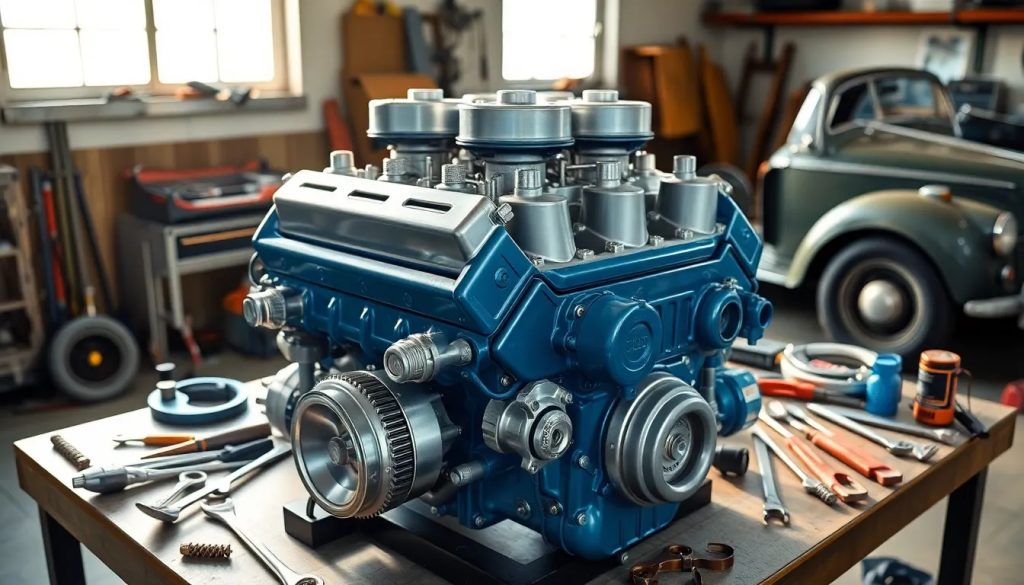Volvo B36 V8 engine overview

The Volvo B36 V8 engine represents a significant chapter in automotive engineering history. Produced between 1956 and 1966, this petrol V8 engine was initially crafted for a concept car in 1952. Known for its unique design and applications, the B36 played a critical role in Volvo's evolution, especially in their commercial vehicle segment.
In this article, we will explore the intricacies of the Volvo B36 V8 engine, including its specifications, horsepower, historical significance, and the various vehicles it powered.
- How was the Volvo B36 engine designed?
- What are the specifications of the Volvo B36 V8 engine?
- What is the horsepower of the Volvo B36 V8 engine?
- Which trucks used the Volvo B36 V8 engine?
- What innovations did the Volvo B36 V8 engine introduce?
- How does the Volvo B36 V8 engine compare to other engines?
- What is the historical significance of the Volvo B36 V8 engine?
- Related Questions about the Volvo B36 V8 engine
How was the Volvo B36 engine designed?
The design process of the Volvo B36 engine was a blend of innovation and experimentation. Initially, it stemmed from Volvo's ambition to produce a powerful engine that could compete in the commercial vehicle sector. The B36 was developed from earlier models, notably sharing components with the B18, which showcased Volvo’s engineering prowess during the 1950s.
This engine features a 3,559cc cast iron V8 configuration, which was quite advanced for its time. Volvo's engineers meticulously designed it to provide a balance of power and efficiency, focusing on the needs of commercial vehicles. The design not only emphasized performance but also reliability, making it suitable for various applications, including marine.
The B36 engine's design also included unique elements such as a central exhaust system, which allowed it to maintain a distinctive sound profile while improving engine performance. Such innovations reflected Volvo’s commitment to pushing the boundaries of automotive engineering.
What are the specifications of the Volvo B36 V8 engine?
The specifications of the Volvo B36 V8 engine showcase its robust engineering.
- Engine Type: V8 engine
- Displacement: 3,559cc
- Power Output: 120 horsepower at 4000 RPM
- Torque: 192 lb-ft at 2200 RPM
- Construction: Cast iron block
These specifications highlight the engine's capability to produce substantial power. The torque provided by the B36 engine allowed for excellent performance in both trucks and marine applications, making it a versatile choice during its production years.
Moreover, the B36 engine had variations tailored for specific uses, such as enhanced horsepower for marine applications. The marine variant could reach up to 180 horsepower, significantly increasing its performance in demanding conditions.
What is the horsepower of the Volvo B36 V8 engine?
The horsepower of the Volvo B36 V8 engine is a critical aspect of its performance characteristics. The standard configuration of the engine produced 120 horsepower, which was adequate for trucks of its era, ensuring reliable power delivery in commercial applications.
In marine applications, the Volvo B36 V8 engine was tuned to generate up to 180 horsepower, showcasing its flexibility. This enhancement made it suitable for a variety of marine vessels, particularly those requiring higher performance levels on the water.
The engine’s horsepower, combined with its torque, provided a robust performance that was critical for Volvo's commercial vehicles, such as the Snabbe and Trygge truck models, ensuring they could handle heavy loads and demanding terrains.
Which trucks used the Volvo B36 V8 engine?
The Volvo B36 V8 engine found its place in several truck models during its production run, particularly in the lightweight series known as Snabbe and Trygge.
- Volvo L420 Snabbe: This model was known for its durability and efficiency, powered by the reliable B36 engine.
- Volvo L430 Trygge: Another model that utilized the B36, the Trygge offered a strong performance for commercial applications.
- Volvo F82 and F83: These models were updated versions that eventually replaced the B36 with diesel variants, showcasing the evolution of Volvo’s engine technology.
These trucks played a significant role in transporting goods across various terrains, leveraging the B36 engine's reliability and power. The transition to diesel engines in later models reflected the industry shift towards more fuel-efficient solutions.
What innovations did the Volvo B36 V8 engine introduce?
The innovations introduced by the Volvo B36 V8 engine were notable for their impact on both automotive and marine engineering. One of the most significant innovations was its unique exhaust system, which allowed for a sound profile that mimicked a V6 while maintaining its identity as a V8 engine.
Additionally, the B36 engine was one of the first to implement a central exhaust port design, which improved exhaust flow and performance. This design element not only enhanced the engine's efficiency but also contributed to a distinctive auditory signature that set it apart from contemporaries.
Moreover, the B36 served as a testbed for future Volvo engineering projects, leading to advancements in engine design for both commercial vehicles and marine applications. Its utilization in military vehicles, such as the TP 21 "Sugga," further underscores its versatility and importance in Volvo’s engineering legacy.
How does the Volvo B36 V8 engine compare to other engines?
When comparing the Volvo B36 V8 engine to other engines of its time, it stands out due to its blend of performance and reliability. Many competing engines during the mid-20th century often prioritized power over efficiency, whereas the B36 managed to achieve a balance between the two.
In terms of specifications, the B36 engine's horsepower and torque ratings were competitive. However, it was the engineering quality and the use of durable materials that distinguished it from others. Volvo’s focus on producing a robust engine for long-term use made the B36 a preferred choice for many commercial applications.
Additionally, when compared to its contemporaries, the B36 engine's adaptability for both trucks and marine applications illustrates its innovative engineering. This flexibility is often not found in other engines, making the B36 a unique offering in the automotive landscape.
What is the historical significance of the Volvo B36 V8 engine?
The historical significance of the Volvo B36 V8 engine cannot be overstated. As one of Volvo’s first forays into V8 engine design, it marked a pivotal moment in the company's evolution. The development of the B36 not only highlighted Volvo's commitment to innovation but also its ability to adapt to market demands.
The engine played a crucial role in establishing Volvo's reputation in the commercial vehicle market. By providing reliable power in the Snabbe and Trygge truck models, the B36 contributed to the company’s growth during the 1950s and 1960s.
Moreover, the engine’s design elements have influenced subsequent Volvo engines, reinforcing the idea that the B36 was not just a product of its time but a stepping stone towards future advancements in engine technology.
Did Volvo ever make a V8 engine?
Yes, Volvo produced the B36 V8 engine between 1956 and 1966. This engine was significant for its applications in commercial vehicles and marine use, showcasing Volvo's engineering capabilities during that era. The B36 was a pioneering engine that helped establish a foundation for Volvo's future in powerful engine development.
How much horsepower does a Volvo B36 have?
The Volvo B36 V8 engine produces 120 horsepower in its standard configuration, which was suitable for its intended truck applications. For marine uses, the engine could be modified to deliver up to 180 horsepower, demonstrating its versatility and adaptability across different sectors.
Does Volvo truck have a V8 engine?
Historically, Volvo trucks did utilize the V8 engine, specifically the B36 model. This engine was integral to various truck models during the 1950s and 1960s, providing the necessary power and reliability for commercial use.
Which Volvo has a Yamaha engine?
Some models, particularly the Volvo Penta series, utilized Yamaha engines, especially in marine applications. This collaboration allowed Volvo to offer diverse engine options, catering to a broader range of marine performance needs.
 Volvo B36 engine specs
Volvo B36 engine specs Volvo D36 engine specs
Volvo D36 engine specs Volvo D39 engine specs
Volvo D39 engine specs Volvo D39 specifications and features
Volvo D39 specifications and featuresIf you want to know other articles similar to Volvo B36 V8 engine overview you can visit the category VOLVO.
Leave a Reply

RELATED POSTS